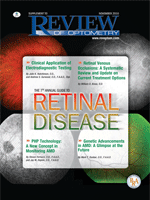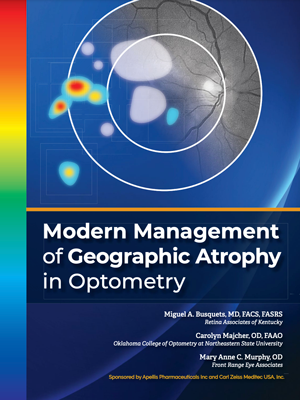The 7th Annual Guide to Retinal Disease
Read PDF Edition
This year’s Annual Guide to Retinal Disease includes:
•
Clinical Application of Electrodiagnostic Testing, pg. 4 By Julie K. Hutchinson, O.D., and Andrew S. Gurwood, O.D., F.A.A.O., Dipl.
Electrodiagnostic testing is often an overlooked and underutilized tool for diagnosing and monitoring several diseases of the optic nerve, macula and retina. Such testing may also be helpful in differentiating subclinical retinal pathologies from functional vision loss. Here, Drs. Hutchinson and Gurwood review several different forms of electrodiagnostic testing as well as discuss how these tests can help clinicians diagnose several devastating retinal conditions, such as retinitis pigmentosa, Best’s disease and Stargardt’s disease.
• PHP Technology: A New Concept in Monitoring AMD, pg. 8 By Steven Ferrucci, O.D., F.A.A.O., and Jay M. Haynie, O.D., F.A.A.O.
Age-related macular degeneration is a leading cause of severe vision loss and legal blindness in patients older than 65 years of age. Fortunately, earlier disease detection
with advanced technologies, such as preferential hyperacuity perimetry, will help give your AMD patients an opportunity to maintain functional vision throughout life. “One critical factor in the successful management of AMD is early monitoring to help detect the onset of neovascular AMD as soon as possible, when lesions are still relatively small and visual acuity is not greatly affected,” explain Drs. Ferrucci and Haynie. Therefore, “The Foresee PHP preferential hyperacuity perimeter (Reichert Technologies) was designed specifically to monitor dry AMD patients for the early development of choroidal neovascular membrane (CNV).”
• Retinal Venous Occlusions: A Systematic Review and Update on Current Treatment Options, pg. 12 (earn 1 CE credit) By William D. Kress, O.D.
Retinal vein occlusion (RVO) is one of the most common acquired retinal vascular diseases in adults. It is your duty to correctly identify the ocular manifestations of retinal venous occlusion, educate your patients on the associated findings, consider indicated laboratory testing, and provide appropriate treatment and management options based upon documented clinical evidence. Here, Dr. Kress discusses the risk factors, symptoms and pathophysiology of RVO as well as several management considerations and treatment options.
• Genetic Advancements in AMD: A Glimpse at the Future, pg. 18 By Mark T. Dunbar, O.D., F.A.A.O.
Anti-VEGF therapy is the current standard of care for the treatment of wet AMD. But, even as remarkable as anti-VEGF treatment is, there are some drawbacks. Fortunately, current and ongoing genetic research has helped us to better understand the intricate disease processes associated with dry AMD development. In the very near future, these findings may ultimately lead to the production of several cutting-edge pharmaceutical agents that specifically target the genes responsible for macular degeneration.
“Even though it may be several years before we actually know if any of these drugs work, it appears that we have taken a giant step forward in combating, or even completely curing, age-related macular degeneration,” Dr. Dunbar concludes.
Additional Publications
-
Modern Management of Geographic Atrophy in Optometry
Hear from several experts, including Miguel A. Busquets, MD, Carolyn Majcher, OD, and Mary Anne C. Murphy, OD, about how to manage geographic atrophy using modern-day tools, technology, treatments and knowledge.
Sponsored by Apellis Pharmaceuticals Inc and Carl Zeiss Meditec USA, Inc Vision and Lifestyle Modern Presbyopic Patient
Reaping the Benefits of Serum Tears in Practice
The Value of Real Tears
A Wider View Of The Retina Advances Care
It’s Time to Talk to Your Patients about Digital Eye Strain



